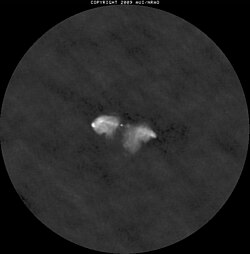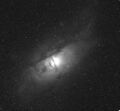Astronomy:3C 285
| 3C 285 | |
|---|---|
 3C 285 in radiowaves | |
| Observation data (J2000 epoch) | |
| Constellation | Canes Venatici |
| Right ascension | 13h 21m 17.813s[1] |
| Declination | +42° 35′ 15.38″[1] |
| Redshift | 0.0794[2] |
| Helio radial velocity | 23,799 ± 5 km/s[2] |
| Distance | 323 megaparsecs (1.05×109 ly) h−10.73[2] |
| Apparent magnitude (V) | 16.23[1] |
| Characteristics | |
| Type | rG, Rad, AGN, G, GiG, QSO[1] G, FR II[2] |
| Apparent size (V) | 0.417' x 0.242'[1] |
| Other designations | |
| DA 343, LEDA 46625, 3C 285, 4C +42.37, 2MASX J13211781+4235153 | |
3C 285 is a radio galaxy located in the constellation Canes Venatici. It is located about 1 bilion light years away. It is a Fanaroff-Riley 2 radio galaxy and is hosted in a disturbed spiral galaxy.[3]
3C 285 is the brightest member of a small galaxy group. Its morphology is peculiar, with an S-shaped envelope that points to another galaxy of the group, located to the northwest. A gas filament 26 arcseconds long extends towards that galaxy.[4] In optical and ultraviolet observations the galaxy features dust lanes, two across the galaxy and one perpendicular to them that also obscures part of the nucleus. Along the edges of the dust lanes knots of elevated ultraviolet emission indicate locations of where new stars are formed.[5] In the centre of 3C 285 lies a supermassive black hole whose mass is estimated to be 107.70±0.10 (40-63 million) M☉ based on stellar velocity dispersion.[6]
When observed in radiowaves, 3C 285 has two lobes with filamentary structures in them, and a jet is visible in the eastern lobe. A blue star forming region, named 3C 285/09.6, has been detected within the eastern radio lobe, and it has been suggested that the star formation was induced by the compression of a region of dense intergalactic gas by the radio jet.[7] The gas mass of the region is estimated to be less than 6.2×108 M☉ based on CO imaging and so it is estimated to be depleted if star formation continues at the current rate in less than a bilion years.[8]
Gallery
3C 285 by the Hubble Space Telescope
References
- ↑ 1.0 1.1 1.2 1.3 1.4 "Query : 3C 285". Centre de Données astronomiques de Strasbourg. http://simbad.u-strasbg.fr/simbad/sim-id?Ident=3C+285.
- ↑ 2.0 2.1 2.2 2.3 "NED results for object 3C 285". http://nedwww.ipac.caltech.edu/cgi-bin/nph-objsearch?objname=3C+285&extend=no.
- ↑ Hardcastle, M. J.; Kraft, R. P.; Worrall, D. M.; Croston, J. H.; Evans, D. A.; Birkinshaw, M.; Murray, S. S. (10 June 2007). "The Interaction between Radio Lobes and Hot Gas in the Nearby Radio Galaxies 3C 285 and 3C 442A". The Astrophysical Journal 662 (1): 166–181. doi:10.1086/517997.
- ↑ Baum, Stefi Alison; Heckman, Timothy M.; Bridle, Alan; van Breugel, Wil J. M.; Miley, George K. (December 1988). "Extended optical-line-emitting gas in radio galaxies - Broad-band optical, narrow-band optical, and radio imaging of a representative sample". The Astrophysical Journal Supplement Series 68: 643. doi:10.1086/191301.
- ↑ Allen, Mark G.; Sparks, William B.; Koekemoer, Anton; Martel, Andre R.; O’Dea, Christopher P.; Baum, Stefi A.; Chiaberge, Marco; Macchetto, F. Duccio et al. (April 2002). "Ultraviolet Hubble Space Telescope Snapshot Survey of 3CR Radio Source Counterparts at Low Redshift". The Astrophysical Journal Supplement Series 139 (2): 411–438. doi:10.1086/338823.
- ↑ Mezcua, M.; Lobanov, A. P.; Chavushyan, V. H.; León-Tavares, J. (March 2011). "Black hole masses and starbursts in X-shaped radio sources". Astronomy & Astrophysics 527: A38. doi:10.1051/0004-6361/201015535.
- ↑ van Breugel, Wil J. M.; Dey, Arjun (September 1993). "Induced star formation in a radio lobe of 3C 285?". The Astrophysical Journal 414: 563. doi:10.1086/173103.
- ↑ Salomé, Q.; Salomé, P.; Combes, F. (February 2015). "Jet-induced star formation in 3C 285 and Minkowski’s Object". Astronomy & Astrophysics 574: A34. doi:10.1051/0004-6361/201424932.
External links
Coordinates: ![]() 13h 21m 17.813s, +42° 35′ 15.38″
13h 21m 17.813s, +42° 35′ 15.38″
 |



